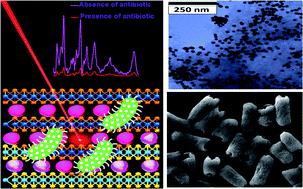当前位置:
X-MOL 学术
›
Nanoscale Adv.
›
论文详情
Our official English website, www.x-mol.net, welcomes your feedback! (Note: you will need to create a separate account there.)
A WS2-gold nanoparticle heterostructure-based novel SERS platform for the rapid identification of antibiotic-resistant pathogens
Nanoscale Advances ( IF 4.7 ) Pub Date : 2020-03-31 , DOI: 10.1039/d0na00141d Avijit Pramanik 1 , Dalephine Davis 1 , Shamily Patibandla 1 , Salma Begum 1 , Priyadarshini Ray 1 , Kaelin Gates 1 , Ye Gao 1 , Paresh Chandra Ray 1
Nanoscale Advances ( IF 4.7 ) Pub Date : 2020-03-31 , DOI: 10.1039/d0na00141d Avijit Pramanik 1 , Dalephine Davis 1 , Shamily Patibandla 1 , Salma Begum 1 , Priyadarshini Ray 1 , Kaelin Gates 1 , Ye Gao 1 , Paresh Chandra Ray 1
Affiliation

|
The emergence of antibiotic-resistant bacteria is the biggest threat to our society. The rapid discovery of drug resistant bacteria is very urgently needed to guide antibiotic treatment development. The current manuscript reports the design of a 2D–0D heterostructure-based surface enhanced Raman spectroscopy (SERS) platform, which has the capability for the rapid identification of the multidrug resistant strain of Salmonella DT104. Details of the synthesis and characterization of the heterostructure SERS platform using a two dimensional (2D) WS2 transition metal dichalcogenide (TMD) and zero dimensional (0D) plasmonic gold nanoparticles (GNPs) have been reported. The current manuscript reveals that the 2D–0D heterostructure-based SERS platform exhibits extremely high Raman enhancement capabilities. Using Rh-6G and 4-ATP probe molecules, we determined that the SERS sensitivity is in the range of ∼10−10 to 10−11 M, several orders of magnitude higher than 2D-TMD on its own (10−3 M) or 0D-GNPs on their own (∼10−6 to 10−7 M). Experimental and theoretical finite-difference time-domain (FDTD) simulation data indicate that the synergistic effect of an electromagnetic mechanism (EM) and a chemical mechanism (CM) on the heterostructure is responsible for the excellent SERS enhancement observed. Notably, the experimental data reported here show that the heterostructure-based SERS has the ability to separate a multidrug resistance strain from a normal strain of Salmonella by monitoring the antibiotic–pathogen interaction within 90 minutes, even at a concentration of 100 CFU mL−1.
中文翻译:

一种基于 WS2-金纳米颗粒异质结构的新型 SERS 平台,用于快速鉴定抗生素抗性病原体
耐抗生素细菌的出现是对我们社会的最大威胁。耐药菌的快速发现是指导抗生素治疗发展的迫切需要。目前的手稿报告了基于 2D-0D 异质结构的表面增强拉曼光谱 (SERS) 平台的设计,该平台具有快速识别沙门氏菌 DT104多重耐药菌株的能力。使用二维 (2D) WS 2的异质结构 SERS 平台的合成和表征的详细信息已经报道了过渡金属二硫属化物(TMD)和零维(0D)等离子体金纳米颗粒(GNP)。目前的手稿表明,基于 2D-0D 异质结构的 SERS 平台表现出极高的拉曼增强能力。使用Rh-6G和4-ATP探针分子,我们确定SERS灵敏度在~10 -10到10 -11 M的范围内,比2D-TMD本身(10 -3 M)高几个数量级或0D-GNPs( ~10 -6到 10 -7米)。实验和理论有限差分时域 (FDTD) 模拟数据表明,电磁机制 (EM) 和化学机制 (CM) 对异质结构的协同作用是观察到出色的 SERS 增强的原因。值得注意的是,这里报道的实验数据表明,即使在浓度为 100 CFU mL -1的情况下,基于异质结构的 SERS 也能够通过在 90 分钟内监测抗生素-病原体相互作用,将多药耐药菌株与沙门氏菌的正常菌株分离。 .
更新日期:2020-03-31
中文翻译:

一种基于 WS2-金纳米颗粒异质结构的新型 SERS 平台,用于快速鉴定抗生素抗性病原体
耐抗生素细菌的出现是对我们社会的最大威胁。耐药菌的快速发现是指导抗生素治疗发展的迫切需要。目前的手稿报告了基于 2D-0D 异质结构的表面增强拉曼光谱 (SERS) 平台的设计,该平台具有快速识别沙门氏菌 DT104多重耐药菌株的能力。使用二维 (2D) WS 2的异质结构 SERS 平台的合成和表征的详细信息已经报道了过渡金属二硫属化物(TMD)和零维(0D)等离子体金纳米颗粒(GNP)。目前的手稿表明,基于 2D-0D 异质结构的 SERS 平台表现出极高的拉曼增强能力。使用Rh-6G和4-ATP探针分子,我们确定SERS灵敏度在~10 -10到10 -11 M的范围内,比2D-TMD本身(10 -3 M)高几个数量级或0D-GNPs( ~10 -6到 10 -7米)。实验和理论有限差分时域 (FDTD) 模拟数据表明,电磁机制 (EM) 和化学机制 (CM) 对异质结构的协同作用是观察到出色的 SERS 增强的原因。值得注意的是,这里报道的实验数据表明,即使在浓度为 100 CFU mL -1的情况下,基于异质结构的 SERS 也能够通过在 90 分钟内监测抗生素-病原体相互作用,将多药耐药菌株与沙门氏菌的正常菌株分离。 .



























 京公网安备 11010802027423号
京公网安备 11010802027423号